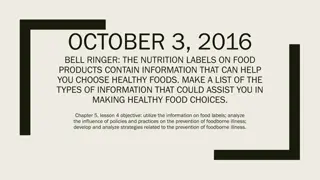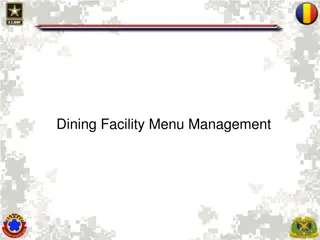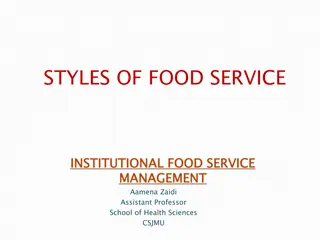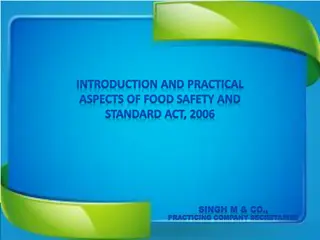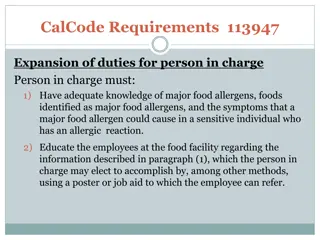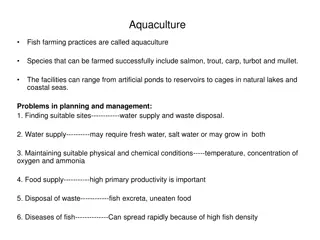Efficient Food Service Management Strategies
Designing an effective layout in food service management involves ensuring a smooth flow of work from ingredient receipt to serving guests. It includes considerations like traffic lanes, work aisles, goods receiving facilities, and storage space allocation. By following these guidelines, kitchens can enhance their operational efficiency and organization.
Download Presentation

Please find below an Image/Link to download the presentation.
The content on the website is provided AS IS for your information and personal use only. It may not be sold, licensed, or shared on other websites without obtaining consent from the author. Download presentation by click this link. If you encounter any issues during the download, it is possible that the publisher has removed the file from their server.
E N D
Presentation Transcript
Subject Title : FOOD SERVICE MANAGEMENT-II Subject Code : 16SCCND9
FOOD PLANT LAYOUT UNIT - V
FLOW OF WORK - LAYOUT A layout is based on a good work flow from the receipt of row materials at good entry to the dishes finally brought it servers for the guest. A well planned layout largely depends on the following requirements which if properly provided for, establish good basic kitchen conditions. 1. Incoming supplies & raw materials (checking & weighing) 2. Food storage 3. Cooking 4. Server arrangements 5. Pan wash arrangements 6. Crockery & cutlery wash up
Traffic lands & work aisles: Work Aisle is An space for walking usually wide enough for workers to comfortably sit or stand at their work area, while allowing safe and efficient movement of persons, equipment or materials. Adequate & properly devised traffic lanes & work aisles are in dispensable to the achievement of satisfactory work flow i.e. in providing straight flow lines for the receipt, preparation & cooking of the product with minimum path crossing & back tracking. Widths of work aisles & traffic lane: 2 feet 6 inches- Allow two persons to pass 2 feet- Trolley width for 1 person to pass 5 feet - Width for 1 trolley to pass 2 persons working back to back 5 feet - Minimum for main traffic lane 3 feet - Minimum clearance width between equipment & work table 3 feet 6 inches-4 feet - Minimum in front of cooking equipment (to which food is conveyed by trolley.
Goods receiving facilities: External space is needed for parking of delivery vans. At goods entry, sufficient space is required for receiving & checking goods, to accommodate a weighing machine, checking table, stand up desk & space for delivered goods prior to storage. For smaller kitchens a separate space within the goods reception area should be provided for waste bins & empty containers. In larger kitchens a separate room for waste may be required. The receiving area should also provide parking for hand trucks & trolleys.
Storage space allocation: As we are aware that various types of stores e.g. dry, vegetable, fruit, meat & cold storage of dairy & fish products are required in a good kitchen. Total storage space should not exceed one quarter of kitchen area for storing of food & equipment. We can calculate space required for dry goods store on the basis of 8- 10% of total kitchen space.
Space Allocation for kitchen planning: Food technology is changing very fast & more efficient equipment is available. manpower & the space is becoming expensive day by day, kitchen layout has to come closer to the actual point of service & guests. This helps to meet the demand for faster cooking & faster service. Guest s demands & tastes are changing rapidly & accordingly a caterer has to change his kitchen plan. Space requirements for any institution, small, medium or large are determined by a number of factors such as location of the food service, customer type and numbers, their ages, socio-economic status, occupation, food and eating habits, likes and dislikes and purchasing power. In addition factors such as menus, customer turnover, service style, method and timings of service all affect the type and size of spaces needed.
SIZE AND TYPE OF KITCHENS The size of the kitchen will vary according to the nature and amount of work to be done in it. Usually the space allotted to a kitchen is approximately half that of the dining area. If kitchen has to service only the adjacent room, its size is usually 40 45% of the dining area. If it provides food to the coffee shop, banquet hall, room service etc as in a large hotel, the kitchen may be as much as 33% more than the dining area. The kitchen space allotment is usually 7 sq. ft. (0.64m2) per guest room as it provides quick service. The coffee shop kitchen is usually 1/4th the area of the shop. In a kiosk, for example, where ready-to-serve snacks are displayed for sale and the only preparation consists of making eggs to order or sandwiches, tea and coffee, the size of the preparation area will be very small compared to the area in a food service, where meals have to be prepared and held hot, or heated before serving. As a rule, it is good practice to provide a compact arrangement of work tables and equipment so that unnecessary time and effort involved in extra walking, stretching and bending is avoided.
As a general guide 2.5m 3m is sufficient for a single person to work in, while 2.5m 4m provide comfortable working space for two persons. Every kitchen should also provide at least 9 10m2 floor area clear of furniture, fittings and stored goods for every three people working in it. For every additional person an extra 7.5m2 would be necessary. Too large or too small a kitchen space to accommodate the necessary equipment will lead to inefficiency in the use of the space. Too small a space will hinder work because of overcrowding, while too large a space will involve extra walking causing unnecessary fatigue to workers. Most importantly, the high cost of the wasted space will reflect unnecessarily high fixed costs, adversely affecting profitability.
Kitchens may take different shapes according to how much space is available in a building for the production and service of food. Kitchens vary from square, rectangular, U-shaped, L-shaped, parallel to a single or straight line with dimensions varying according to the need of particular catering establishments. Square Kitchen The square kitchen is not so common as the distance from one wall to another is more and requires much walking at work. It is also difficult to use the centre space effectively except for an aisle or for odd jobs that may even come in the way of the main cooking and preparation activity. All plumbing, electricity and gas connections are best brought to wall ends rather than having pipes and drains under floors in the centre of the kitchen. If this is done any leaks that may occur will flood the centre of the kitchen making it unhygienic and unsafe, as well as difficult to work in.
Rectangular Kitchen Rectangular kitchens are a very common shape in catering establishments, and generally used where a lot of activity is undertaken for most of the day. In large establishments, where many different types of menus are served, and more space is required, rectangular kitchens prove useful. Ample examples can be seen in hospitals, large restaurants and central kitchens. U-Shaped Kitchen U-shaped kitchens are the most efficient type, being compact and step-saving. Doors are located at the end of the U and the dining area around the three sides of the room. The sink unit is placed in the end-wall, or inside the U , with a window over it. There is no chance of criss-crossing in such a plan and work flows easily from one centre to the next. Counters can be fixed to come down on either side and provide additional service space during peak hours, and can be folded back against the walls after service hours.
L-Shaped Kitchen L-shaped kitchens make use of two walls adjoining at right angles. It is an efficient design where floor space is limited. Extra space can be created by use of revolving shelves installed in a cabinet at the base of cooking and sink units. It is a very useful shape for small canteens, kiosks, tea and coffee shops. Parallel Kitchen In parallel kitchens the sides of passages may be utilised while the centre space acts as an aisle. The passage may be slightly screened off on one side for service during peak hours. This sort of plan is best suited to cafeterias of the self service type. This shape is suitable for midday meals in schools where dining facilities are not possible. The central passages with walls at least 1.2 to 1.5 metres apart can be used for children to squat on mattresses and eat the plated food served. More often children like to eat standing or playing and so carry the food away from the area of service.
Straight-line Kitchen This is sometimes referred to as an I-shaped kitchen. It is a useful arrangement for kiosks, tea shops, the straight line kitchen or mobile vending units. The extra storage is created on walls or under sinks through cabinets. For service, there is provision for a platform or extended counter outside a window. Window spaces can be shelved and covered with wiremesh shutters to increase display space and protect from flies, while at the same time providing enough ventilation in small spaces.
Combination of shapes Any of the shapes discussed above can be combined To plan out a kitchen, depending on the space Available in a building. Sometimes very different Shapes can emerge during the process of renovation Or expansion of catering facilities. In buildings where catering is not the main Activity but forms an area that complements the Main services such as accomodation, conferencing Etc. In hotels, or medical services in hospitals, the Space allotted to kitchens is usually what can be spared after the main services are planned. This can lead to unplanned space allocation, ending up with Shapes and sizes in which a lot of creativity and innovation is required to make it effectively operational and pleasant to work in.
DEVELOPING KITCHEN PLANS Before and kitchen plan can be developed, it is important to follow four main steps: Formulate list of activities to be performed. Break activities into jobs or tasks. Work out the simplest ways of performing the tasks. Arrange tasks into sequences for smooth operation. Step 1: Formulate a list of activities that are to be performed in the kitchen. In the process of scheduling, the activities are organised into a production cycle which shows the sequence in which the listed activities are to be performed, and their interrelationships.
ACTIVITY AREA OF ACTIVITY Stores TASKS Storage Get flour, butter, sugar, eggs, cherries, etc. Collect all equipment required. Sift powdered ingredients together. Cream sugar and butter. Beat eggs and gradually add to the creamed mixture. Pipe or spoon mixture into cases or in cookie trays, placing a piece of cherry in the centre. Preparation Kitchen Cooking Kitchen Bake in preheated oven for 10 20 minutes. Take out of oven and let cool on wire rack. Serving Canteen counter Washing centre Arrange on tray with cake cover and display for sale. Collect mixing bowls, beaters, spoons and baking trays and wash up. Washing up Task breakdown for preparation of fairy cakes
Step 2: Each part if the production cycle is then broken up into jobs or tasks which need to be performed in a particular order to achieve the objectives of a food service establishment. Step 3: Once the tasks have been defined, one has to think of the simplest ways in which they can be performed. Step 4: The tasks are then arranged in a sequence so that one task can smoothly follow another to establish what is termed as work flow in any operation. WORK SIMPLIFICATION Work can be simplified by viewing the kitchen and its activities from five different aspects namely: (a) Work area (b) Worker s area of reach (c) Work space (d) Equipment, materials and supplies, and (e) Movements at work.
Work Area This refers to the area of the work surface, its height from the floor, location of the equipment and materials to be used on the work surface. It is recommended that for a worker performing a task in the standing position, the height of the work surface from the floor should be just below the waist-line, so that there is no need to bend at the waist or hip while performing the task. If the surface is too low, backache and general discomfort will result, and if too high will cause undue muscular strain and fatigue. A sink unit top should be higher than a food preparation surface to take into account the need for reaching down to the base of the sink in the former. Likewise gas stoves should be fixed at a lower level than the work surface so that when a cooking pan is placed on it, the contents can be seen and stirred without standing on one s toes. When working in a seated position unnecessary stretching or straining of the neck muscles should be avoided. For comfort, feet should rest flat on the floor.
Average recommended heights in work areas Description Height for work surfaces Work surface Shelf under work Sink top Bottom of wall units above work top Highest shelf for general use Top of highest unit Heights (in cms.) 90 85 100 surface 80 95 90 100 135 180 225 Well planned work areas not only provide physical comfort, but also contribute to a sense of psychological and social well-being within the work environment.
Workers Area of Reach The area of reach signifies the limits to which a person can stretch his or her hands to grasp materials and equipment, required for an activity. If the arms of a worker are fully extended outward to form a circle on the work surface, the area within the circle is termed as the area of normal reach. A worker can reach any object in this area without stretching or moving other parts of the body. It is the most comfortable area of work involving the least amount of energy. While performing any food preparation activities, items part-prepared should be kept within the normal reach area as these will be required soon after to finish the dish. Items which have to be kept aside for 1 2 hours as in the case of soaking pulses and legumes, marinating meats, may be kept in the effective reach area. whereas, foods or mixtures required to be kept overnight or longer as for fermentation, sprouting, etc. may be stored adequately in the maximum reach area.
Movements and Work One needs to become conscious of how body movements are related to the amount of energy consumed. For this, it is necessary to understand that the body has been designed so that its weight is evenly distributed over the legs. When working in any position standing or seated, the centre of gravity of the body is disturbed. This causes unequal distribution of weight on the legs resulting in extra energy consumption to maintain the body position. If the balance is continuously disturbed in any activity, muscles get tired, and fatigue sets in. For all positions at work therefore, one must keep the body in physical balance, i.e. maintain correct posture to enhance comfort and conserve energy. This fact is realised when we observe that some jobs are tiring for some people and not for others, this is because some people waste their energy because of wrong postures and therefore less energy is available for the job, which consequently does not get completed as best as possible and in the shortest possible time. Developing the art of muscle coordination to perform work with a tireless rhythm may require a conscious effort, but it is worthwhile making it till it becomes a habit the habit of not getting tired at work.
Work Space The amount of space available for work is important for completing tasks efficiently. The space should be large enough to place all the materials and equipment required, as well as allow for movement at work. In addition, extra space in necessary for placing completed parts of the work which need to be kept aside till required again. Insufficient work space will involve extra movements in trying to go elsewhere to put away the partly or fully completed work and come back to the next activity. The work space should also allow for the keeping aside of used and unused equipment, away form the food in process. This can be done by using shelf space and areas under tables intelligently. Equipment, Materials and Supplies Equipment, materials and supplies, all have to be considered in relation to the physical structure of the kitchen and the persons using them. Their placement, suitability, quality and quantity, all determine how simple any work can be made. This awareness helps to establish plans that are economical in terms of human effort, time and other valuable resources.
Any materials, supplies or equipment in regular use should be placed within the maximum reach zone, because activity is concentrated in the zone of normal reach. Shelves may be located within these zones for items which are used occasionally. This helps to increase the space within the work area. Heavier items are better kept on upper shelves. As far a possible, equipment should be kept ready for use in the normal reach zone, along with other ingredients and supplies used frequently to complete any task efficiently.
DESIGNING KITCHENS Physical Aspects These include location, structural details, the layout, storage spaces, services available and required, access to sources of supply, staff and customers, and other local requirements with respect to planning, environmental health, fire and other safety concerns. Location As far as possible, the kitchen should be adjacent to the service area, and preferably in one corner of a building, in a North-West or South-East direction. This provides two side walls for windows and free access to air and natural light. A corner location also makes it accessible by road for purposes of receiving supplies and removal of kitchen wastes. The kitchen should be situated over ground to avoid flooding, drainage backflow and unnecessary expenses on artificial lighting and ventilation. In basement areas, the humidity and heat of kitchens also make them prone to dampness and infestation.
Structural Features These include drainage, electricity, gas connections, and water supply systems. These are generally provided for before the equipment is installed, Other features include the design and finish of floors, walls, ceilings, and work surfaces, followed by lighting and ventilation. Last, but not the least, the structure must be safe, and provide hygienic and sanitary conditions for those who work in it. Drainage: The efficiency of the drainage system determines the hygiene and sanitation of the kitchen environment. Poor drainage further leads to contamination of food with dire consequences. Problems can arise in drainage areas when fat gets collected in the drains and restricted the flow. All kitchens should therefore be fitted with grease traps on all drainage inlets to prevent backflow or blockage. Taking care of this aspect of drainage during the layout planning, can prevent unnecessary expenses. Drains should be at least 10 15 cm in diameter.
Electricity and Gas connections: Electricity and gas points to be provided in a kitchen must coincide with the plan of equipment in the kitchen and future plans for use. Depending on the size of the catering unit the requirements may vary from one power point and two light points. as in the case of a kiosk, to three power and four light points, as in the case of a cafeteria kitchen, which may require to use a refrigerator, a mixer, and a juicer, in addition to lighting the area of display for food and dining. For larger kitchens, it is safer and more economical to have a pipeline gas supply which is metered as in the case of electricity, thus avoiding the inconvenience of gas cylinders getting empty in the middle of food preparation activity. Gas cylinders may be used by very small establishments where the menu does not feature many cooked items. All pipeline arrangements or wiring should preferably be concealed in the walls, flooring or ceilings. Any unconcealed sections must be properly insulated and earthed, both for economy and safety. It is wise to make provision for more than one type of fuel in any kitchen to cope with failures and shortages.
Water Supply: In large kitchens provision for both hot and cold running water is necessary and has to be made at the structural stage. For smaller kitchens, arrangements for fitting a water heater above sink units may be sufficient. whereas in kiosks and coffee shops provision for the installation of instant water heaters connected with the normal plumbing is quite effective. All water supply into kitchens must be from purified sources Overhead water pipes should be avoided as they collect dirt and cause water of condensation to drop on the work areas. All pipes should preferably be concealed. Where storage tanks are necessary, they should be covered and easy to clean periodically. Separate provision for drinking water is necessary. Floors: Kitchen flooring should be smooth but not slippery, hardwearing, free from joints, not easily damaged by spillage, easy to clean, and preferably in dark plain colours which do not show patches easily. Choice should also take into account appearance and durability. There are a number of flooring materials available on the market. It is good policy to avoid any type of tiles as they require a number of joints which are not easy to clean out. A comparison of different floor coverings indicating suitability appears
Walls: Hard plaster with an emulsion finish is the most suitable as it is without joints, smooth, easy to clean, and does not harbour dirt. Enamel and oil paints are also hardwearing. A particular type of finish cannot be specified for a kitchen because the manager of the kitchen must decide what properties should be given priority. Each wall covering has its own plus and minus points. Whatever the choice, the walls should be smooth, easy to clean, and impervious to moisture. Ceilings: Any finish on ceilings should be heat resistant and not affected by steam or gases. A plaster paint finish is most suitable, though it requires frequent Redoing. acoustical ceilings are important for absorbing kitchen noise. In general, while choosing finishes for walls, floors and ceilings it would help to remember that dark colours reduce the level of illumination and affect the visibility in kitchens. It is also a good policy to invest on quality for longlasting effects.
Work Surfaces All work surfaces should be hardwearing, smooth and impervious. Stainless steel is by far the best among work surfaces in the kitchen, though the initial cost is much higher than that of any other surface finish. Work surfaces can be covered with laminated plastics, hardwood or ceramic tiles, with certain sections in marble or stainless steel, to reduce the cost. Laminated plastics are quite easy to maintain and not very costly, but they need to be inspected at regular intervals and replaced if they begin to lift at places. Hardwood work surfaces are a possibility but would need a lacquered finish to be practical in an institutional kitchen. They also get easily stained and marked and are expensive to install and maintain. Marble though expensive is ideal as a work surface for food preparation work, because of its hard wearing and hygienic qualities as well as beauty.
Lighting Kitchen lighting should be designed purely to give the best illumination. In addition to overall lighting, fittings need to be placed directly above work tables and food preparation areas. Many types of lighting are available for use in institutional kitchens, such as fluorescent, filament and mercury lamps. Fluorescent Lamps: Fluorescent lighting is more economical to use than filament lamps, because even though the initial cost is more, its maintenance cost is lower. Fluorescent lighting lasts almost six times as much as filament lighting, and gives three to six times more illumination for the same electricity consumption. The colour effects of fluorescent lighting is correlated to the colour temperature. High efficiency fluorescent tubes reaching a temperature of 3000 to 4300 K do not give particularly good colour effects, and are not recommended for use in kitchens, dining or storage areas where the colour of the food couldbe masked. Mercury Lamps: Mercury lamps may be used in kitchens, and are available in ranges of 80 to 400 watts capacity. The colour, appearance, illumination and life are approximately equal to white fluorescent tube lamps. Enclosed fittings give diffused light, provide greater comfort to the eye, and can also be fixed to false ceilings. The seal protects the lamp from moisture and dirt and is also easier to clean. Thirty watts of lighting is recommended per square metre of floor area if fluorescent lights are used.
Filament lamps: 80 watts per square metre area would be necessary. The illumination recommended for performing a task is 500 lux. The mounting height should not be less than 2.4 metres above the floor. Additional lighting is necessary under steam canopies, and any lighting equipment used should be of rustproof material and able to withstand moisture and heat. All fittings need to be arranged over work surfaces and not behind the workers. Light fittings should be totally enclosed, water proof and easy to clean. Ventilation Ventilation in kitchens is very important to prevent the contamination of food. Good ventilation helps to replace oxygen used by workers during respiration, and sets up a current of fresh air which drives out kitchen odours and fumes through suitable outlets provided. It also eliminates excessive heat from the cooking environment, regulating the temperature and making it more comfortable to work in. Therefore sufficient attentions needs to be paid to good ventilation and lighting in food preparation and service areas as it is vital to the preparation and provision of safe food, and through it the safety of the customers. The modes of ventilation in kitchens are windows, vapour extractor hoods and exhaust fans. To be useful, windows need to be fitted with fly-proof shutters.
Vapour extractor hoods are generally fitted over cooking equipment, and have proved very effective in removing fumes, vapours and odours from kitchens. Exhaust fans are fitted near the ceiling in the walls. They are designed to suck out the air from kitchens, which then gets replaced with fresh air. The area is wiremeshed on the outside to make it fly proof. It is important to keep in mind that the kitchen environment should be made as bright and cheerful as possible. Colours like blue, beige and cream are cool to the eye, and counteract the feeling of heat in kitchens. Light colours also give better visibility, while equipment and furniture of natural colour adds to visual comfort. A harmonious environment is stimulating and helps to bring out the best in people in terms of skill, creativity and therefore productivity. Designing for Safety In the process of designing kitchens it is vital to make provision for safety through installation of fire-fighting equipment and emergency exists, placed at convenient points such as in cooking areas and electrical danger zones. In small establishments it may mean only one fire extinguisher, but nevertheless the awareness of its need is essential. Also alarm systems need to be incorporated while designing kitchens. A good plan also provides air circulation and staff movement patterns that promote both physical and physiological safety through tight controls. The plan needs also to establish, a smooth flow in the area of garbage removal to minimize the time for which waste materials stay in the kitchen or near service areas.
For successful layout planning it would be useful to remember that: The placement of equipment in centres should allow plenty of space around them for cleaning. Units built into walls help to save space in small kitchens. Free standing equipment rather than that placed flat on the floor is more hygienic. Sometimes in restricted spaces mobile equipment is useful not only for cleaning but to make the layout more flexible to suit the needs of the establishment at different times. An island layout is easier to clean and work in. with the work tables placed against the walls, between sinks, ovens and stoves and machines in the centre of the kitchen, they become easily accessible to all individuals working at different centres. Wet preparation and cooking units near external walls avoid drainage pipes passing through the kitchen. Walls and floorings should not have sharp turns and all areas should be visible to people when they are walking. Traffic lines used by staff should not criss-cross. Layouts should ensure that food is not handled repeatedly. It should flow in a single direction. It is preferable to set up separate raw and prepared food areas to prevent cross- contamination. In addition, plans should account for the provision of employee restrooms with washing and toilets facilities, built in lockers for keeping their clothes and valuables while at work in their uniforms or working clothes.
STORAGE SPACE Storage involves arranging goods in specified areas within spaces earmarked for particular materials, till they are required for use by the production, service or other departments. SPACE ALLOCATION Spaces allocated for storages depend on three basic factors. Nature of foods and other materials to be stored. Quantities in which they are stored. Length of time for which they are stored before use. The planned arrangements in a store are generally referred to as functional storage as it provides a facility which makes ingredients available for use with the least possible delay. TYPES OF STORAGE There are basically two types of storages, dry and low temperature. These are further subdivided according to the temperatures required by different foods to maintain their quality.
Types of storage Storage Type Temperature C Foods DRY Room temperature 20 - 25 pulses, cereals, processed COLD Refrigeration 3 - 10 milk, eggs, Cold storage 0 -3 Fruits Freezer 18 to 20 Frozen Foods DRY STORAGE: As the name suggests, dry storage is a space designed for the storage of dry ingredients which are usually stored at room temperatures between 20 25 C. The storage should be dry, cool, well lighted, ventilated and free from infestation to maintain the food in good condition. Depend largely on the type and size of the establishment and its catering policy in terms of buying procedures, menus.
Dry storage is suitable for non-perishable and semi-perishable commodities, the latter being stored for a shorter time. Dry storages may be divided into five distinct categories as follows: Food Store This store is mainly for the storage of some semi-perishable and all non-perishable items. While most non-perishables can be stored together in a storeroom, some semi-perishables like under ripe fruits and vegetables, potatoes and onions, bread and eggs require separate ventilated storage facilities. Fruits and vegetables need to be stored for ripening. Firm green tomatoes, underripe bananas, lemons and other citrus fruits, require a temperature of 18 C to 24 C while potatoes and onions require a temperature of 4.4 C. Foods which need to be held only for 2 3 days require a temperature of 10 C to 15.5 C, like breads and bakery products. Fuel Store In large catering establishments the fuel store should be separate from food and other material storages, located preferably outside the kitchen as it is inflammable in nature and can prove dangerous if fuel especially gas (LPG) is stored in it. Space allocated for storing fuel depends on what kind of fuel needs to be stored whether kerosene oil, LPG, coal or wood. In smaller kitchens single sealed cylinders may be stored in cupboards built in the kitchen. But care should be taken to see that all cylinders are well sealed and those in use switched off or locked when work is over.
Store for Cleaning Supplies This must be separate from any food store, as it includes detergents of all kinds, brushes, mops, etc. If stored in the same storage space as the food, these should be kept in a separate section, screened off from food materials. Equipment Store This involves storage of spare kitchen equipment, service equipment, spare parts of gadgets, and may also be combined with miscellaneous items like linen, stationery, disposable mats, crockery and cutlery. Trash Store This includes storage space for waste materials from all points of production, such as delivery points, storage, service and clearing up areas. This is usually a designated space outside the kitchen from where it can be cleared and disposed off by the local authority staff incharge of waste management.
Low Temperature Storage The principle underlying to inhibit the growth of microorganisms, thereby preserving the food. At high temperatures, microbial activity gets accelerated because perishable foods have relativity high proportion of moisture, providing suitable humidity for spoilage to occur. There are three distinct types of low temperature storages based on different temperature ranges, maintained for the safe storage of semi-perishable and perishable food, namely refrigerated storage, cold storage, and freezer storage as indicated. Refrigerated Storage Refrigerated storage is a space planned and maintained at a temperature between 0 and 10 C. It can be in the form of a complete room or a cabinet which is freestanding or fixed in the wall. Such storages are necessary for maintaining the quality of perishable foods for 3 5 days. Frost-free and automatic defrost models are also marketed for ease of cleaning and use. It is good practice to keep foods covered in refrigerated storage to prevent them from drying. This also prevents odours from one food being picked up by another. The space required for refrigerated storage is determined by a number of factors such as the volume of food produced, type of menus, preparation and cooking methods used.
Cold Storage Cold storage is generally one in which the temperature is maintained between 0 and 5 C, thereby reducing the enzyme activity in foods to a minimum. Such storages are also called chill rooms and can hold perishables for over a week, and in the case of fruits and vegetables, even up to a month depending on their stage of ripeness and variety. Freezer Storage In freezer storage the temperature ranges from 0 to 20 C depending on the time for which a food is to be stored. For successful freezing, it is necessary to blanche foods, cool quickly to freezing temperature and pack in airtight containers. Freezer storages may be in the form of wall or free standing cabinets, or a part of cabinet in which there is refrigerated storage as well. In the case of large central kitchens, supplying meals to schools, offices, and airlines, freezer storages may be a room designed to maintain the required temperatures. These are also referred to as walk-in freezers.
LAYOUT Every store should aim at reducing mental and physical strain, time and effort of store staff in locating items when required, by placing them correctly on delivery. Depending on the size of the store, a reception platform of approximately 90 cm in length at the delivery point helps to prevent excessive lifting. The delivery vans can reverse upto the platform to offload the commodities at a receiving area which is located close to production and storages so that both the areas can be serviced simultaneously, the fresh perishable ingredients going straight for production and the rest for storage. Usually a receiving dock 2 3 ft (0.76 0.91 m) high and 8 ft (2.44 m) deep serves the purpose of direct off loading from delivery van to storage areas. The length of the dock can be varied according to the average volume of delivery. space necessary for placing weighing equipment and counters for inspection of goods. A make-up counter in the centre is often necessary for holding commodities before they can be arranged in their assigned places in the store or issued directly to user departments. This can be achieved by using mobile racks with adjustable shelving, baskets and trolleys for placing items in a systematic manner. Whatever the type of arrangement, store items must be placed at heights which allow for easy reach and readability, so that time is not wasted in trying to search for items when required. There should also be sufficient clearance between items, to allow them to be easily reached and replaced.
Structural Features The ceiling of the store should be at least 3.5 4 metres high with provision for ventilation and lighting all protected by grills for security. Enamel painted walls and ceilings, with floors of concrete or heavy tiles are recommended to withstand wear and tear resulting from the movement of goods on trolleys or carts. Construction of ceilings, floors and walls should be aimed at easy cleaning to maintain hygiene; walls near floors should be damp-proofed to prevent microbial infestation and spoilage of foods. It is preferable to have racks or shelves of metal or any other nonporous material, situated at least 5 cm from walls, or placed in the centre of a room with aisles around them, so that each part of every shelf is accessible. The space between the shelves may vary from 50 cm to 90 cm, depending on the size of the containers to be stored. For small cans or jars 30 40 cm is the usual spacing. The recommended height for racks is 2.3 m. racks higher than this will pose problems in reaching for placing and issuing of items, fixing of lighting, etc. For the storage of jutebags or cartons, slatted platforms with 8 cm clearance from the floor are advisable, for free air circulation hrough piled goods. A work table is necessary near the entrance of a storeroom for replacing or handling of requisitions and issuing of stores. Provision of scales either fixed on the wall nearby or placed on the table, are important for issuing small quantities.
Lighting Fluorescent lamps in trough fittings placed in a row at right angles to the shelving are the most suitable because light penetrates best from this angle into each shelf. If the shelves are light coloured, the light gets cross reflected for greater advantage. Lights should be fitted high enough above the topmost shelves of the store to prevent damage to fittings while goods are being placed or removed. Lights fitted too close to food items also generate heat which can affect the quality of semi-perishable stocks. Ventilation Windows and exhaust fans provide suitable ventilation for storage, but these should be situated high up in the walls to provide ample and uninterrupted circulation of air, while preventing direct draughts on the foods stored. Door openings should be large enough to allow free passage of supplies and equipment. This is usually 3 ft (1.07 m) for single and 5 ft (1.52 m) for double doors.
SANITATION, SAFETY AND SECURITY OF STORES Hygiene and Sanitation Hygiene and sanitation in and around stores is of paramount importance. It is therefore necessary to keep stores neat and clean and to prevent attack of food by bacteria and molds. Dry food stores should be fly-proofed and walls treated with suitable insecticides. All stores should be guarded against rodents and pests, to safeguard both staff and customers against infested and contaminated food. It is good policy to formulate a schedule or chart for regular cleaning and maintenance of stores. The following points may be kept in mind while preparing a schedule: Wash floors, walls and shelves once a week or fortnight and disinfection of spaces. Inspect incoming food for signs of damage, spoilage or infestation before storing. Arrange food systematically, so that old stocks are used first. All opened packages should be put in covered, air-tight containers before re-storing. Foods of similar type should be stored together.
The safety hazards to which stores can be exposed are: Infestation or contamination of food held in storage. Theft or pilferage. Microbial spoilage due to improper temperature and humidity controls especially in cold storages. Fire.
All windows and other openings should be well guarded with mesh and grills. a) There should be only one door for entry into and exit from stores. (b) The storekeeper s office must be positioned such that supervision is possible at all times and the door is in full view during working hours. At no time should the store be left unmanned. (c) Issue counters must close by roll-down shutters or half doors. (d) Safety locks must be fixed and the keys to the stores should always be kept in a safe under the charge of a single responsible person. Safety devices such as automatic locks, number locks, built-in alarm systems against fire, gas leakages and theft are now available in various models and sizes. Their placement at strategic points in a catering establishment is a wise investment. (e) A guard on 24 hour duty is important. Well-guarded exits inhibit pilferage if a personal checking system is established when staff go off duty. Thus a good store must provide: Wholesome ingredients for food production and service. Proper temperatures and humidity for prolonging the shelf-life of various type of food. Suitable space and structural equipment arrangement for providing sufficient light and ventilation. Suitable barriers against pests and rodent infestation. Ease of cleaning and access to materials in the store. Foolproof quality control arrangements for the receipt and issue of goods. Safety and security.




















